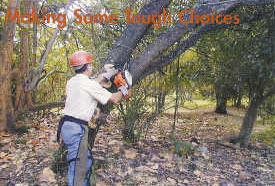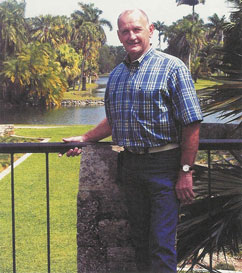Making Some Tough Choices
Don Evans, Former Director of Grounds Management
 |
| Luis Marrero removing Picrodendron macrocarpumfrom the collection |
At Fairchild Tropical Botanic Garden, as at any museum, collections are our stock in trade. During the 66 years of Fairchild's existence, the staff and collaborators have traveled worldwide to amass the outstanding plant collections for which we are known. Dr. David Fairchild wrote eloquently about his exciting travels in remote areas of the world to collect new and wonderful plants to be introduced to South Florida. Staff members from the Research and Horticulture Departments continue to explore such exotic places as Madagascar, Papua New Guinea and Central America to add new species to the already-extensive collections.
However, acquisition is only the first step in maintaining important botanical collections. It is followed by years of curation, which entail care and maintenance, record keeping, study, comparison and interpretation. Alas, good stewardship also requires the occasional tough choice to dispose of a valued species.
We all know of the exotic species that have become major pests and are threatening disruption of South Florida habitats. Melaleuca quinquenervia, introduced for the express purpose of drying up the Everglades for farming and development, has succeeded all too well, colonizing great portions of the Everglades and costing federal and state governments millions of dollars to try to control it. Brazilian pepper, Schinus terebinthifolius, brought in as an ornamental plant because of its winter display of red berries, now invades natural areas, fruit groves, roadsides and home gardens. The Florida Exotic Pest Plant Council lists more than 70 species of invasive plants that are altering native plant communities and displacing native species; and 56 that are causing concern due to their increasing abundance.
Having learned a valuable lesson from the performance of known invasive exotic species, the Horticulture and Research staffs faithfully monitor Fairchild's collections to prevent the introduction of species likely to be invasive. At times, seemingly benign species find niches and exploit them, becoming pest species.
 |
| Don Evans at the Bailey Palm Glade |
In the 1960s, when Dr. John Popenoe and Gerald Pitt were developing the Bahamas Collection in the lowland, logwood, Haematoxylum campechianum, was introduced as a plant common to the region: its flowering was greatly enjoyed by the staff and visitors. Logwood had played an important role in the years of European exploitation and colonization of the New World. As the source of a valued black dye and ink ingredient, logwood was a prized commodity in the 16th and 17th centuries. Ships carrying it were chased down by privateers and buccaneers, and the logwood sold in London at enormous prices. After finding so many references to it in his research for the novel Caribbean, James Michener came to Fairchild to see logwood. Logwood also was featured in the tours for the children's program. Thus it was a disappointment when seedlings of Haematoxylum began appearing in the fringes of the mangrove preserve. The tough decision was made to remove it from our collections and eradicate its progeny.
Another Bahamas species, Picrodendron macrocarpum, existed in the Fairchild collections for more than thirty years, with no signs of invasiveness until very recently, when it was found sprouting in the mangrove areas some distance from the parent plants. Ricardo Aberle and the grounds crew have removed the accessioned plants; the volunteer plants are being sought out and eradicated.
Other exotic invasive plant species that are targets of an ongoing control effort are jacquinia aurantiaca, Colubrina asiatica, Alstonia macrophylla, Thespesia populnea . . . and the ever present Brazilian pepper, Schinus terebinthifolius. Robert Ziebro is the warrior who spends part of every day searching out rogue invasive plants and dealing with them. Fairchild's horticulturists and curators work with Fairchild's Conservation Team and the county's Natural Areas Management agency to ensure that Fairchild's plants are not moving out and adversely affecting areas outside Fairchild's walls.
Sometimes the tough choice has to be made to do away with a species that has been a favorite ornamental or has had special interpretative value. Our responsibility to the local and global environment demands that these tough decisions be made.
Garden Views Summer 2004